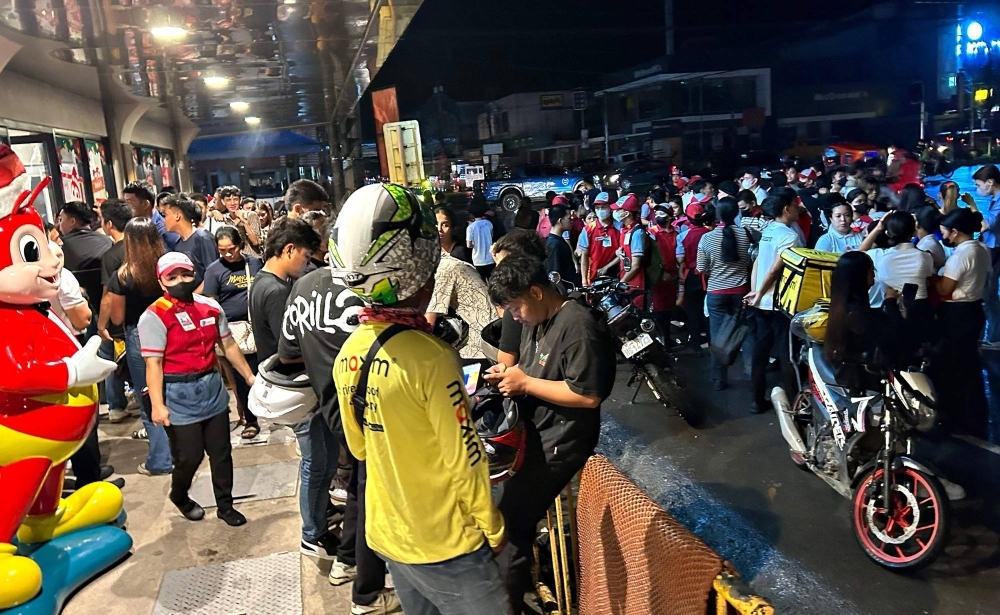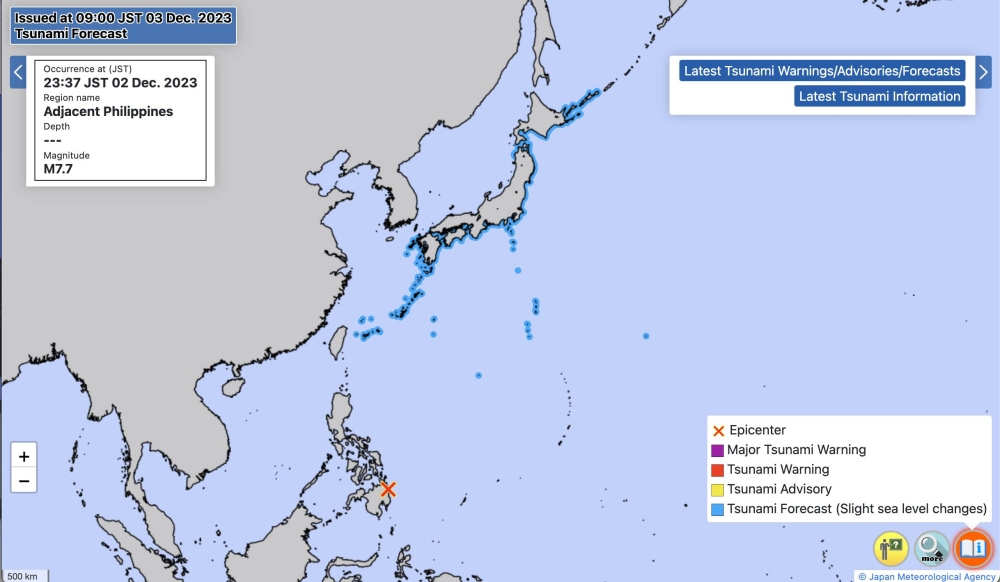Japan lifted all tsunami warnings on Sunday, hours after a powerful magnitude 7.6 earthquake — followed by four major aftershocks — struck the southern Philippines, sending residents fleeing from coastal areas.
The initial quake struck off the coast of the country at a depth of 32 kilometers at 10:37 p.m. local time about 21 km northeast of Hinatuan municipality on Mindanao island, the U.S. Geological Survey reported said.
Early Sunday, over the span of several hours, four powerful aftershocks of magnitudes 6.4, 6.2, 6.1 and 6.0 rumbled through the region, the USGS said.
The initial quake, which Japan’s Meteorological Agency measured at magnitude 7.7, triggered tsunami warnings across the Pacific region and sent residents in northeast Mindanao fleeing buildings, evacuating a hospital and seeking higher ground.
At 4:27 a.m. Sunday, a 40-centimeter tsunami was observed in the Pacific island of Hachijojima, part of Tokyo, the agency said, while Kushimoto, Wakayama Prefecture and Tosashimizu, Kochi Prefecture, recorded tsunami of 20 cm around 5 a.m.
The agency lifted all tsunami advisories for Japan around 9 a.m.
The Pacific Tsunami Warning Center in Hawaii also issued an alert but later posted that the danger had passed.
The Philippine Institute of Volcanology and Seismology said in a bulletin at 3:23 a.m. local time that the highest waves generated by the seismic activity were 64 cm tall on Mawes Island, but that the tsunami warning had ended.
Small swells were reported as far as Japan’s eastern Pacific coast, where a tsunami advisory was also briefly in effect. Palau, a western Pacific archipelago some 900 km off Mindanao, reported no impact.
Hinatuan police Sgt. Joseph Lambo said the quake was “very strong” but that there were no reports of casualties or major property damage.
“Appliances fell off the shelves at the police office and two TV sets were broken. The motorcycles parked outside also tumbled down,” Lambo said.
“Right now we don’t have reports of damage or casualties but people are evacuating because of the tsunami alert.”

People gather along a street after evacuating following a 7.6 earthquake struck Butuan City, in southern island of Mindanao.
| AFP-JIJI
Lambo said the 45,000 residents in the municipality had been ordered to leave their homes and many were going on foot or in vehicles to higher ground.
A video posted on social media and verified by reporters showed bottles of drinks and other products falling off shelves in a convenience store as staff fled outside.
Another video, shot by Dennis Orong, showed people screaming as they ran along a street in Lianga, a coastal municipality of Surigao del Sur.
“I was shaking in fear, mainly because of exploding electric poles,” the 26-year-old hairdresser said.
“It was very traumatic.”
Social media reports of a tsunami hitting Lingig municipality, about 35 km south of Hinatuan, were “fake news,” said police Master Sgt. Robert Quesada.
“We’re at low tide,” he said.
“People evacuated away from the coast soon after. We can’t say how many at this point, but pretty much the entire town is along the coast.”
Many people, including Bethanie Valledor, were asleep when the quake struck.
“I felt like the room we’re staying in would be destroyed,” Valledor, 24, said after fleeing the resort where she had been staying, about 20 km southwest of Hinatuan.
“Our place is very near the sea. The resort owner asked us to evacuate immediately. Honestly, I was screaming. I panicked.”
In the city of Butuan, northwest of Hinatuan, orderlies evacuated patients on gurneys and in wheelchairs from a hospital, their drip and IV bags hanging from support stands.
The quake came nearly two weeks after a 6.7 magnitude quake hit Mindanao, killing at least nine people, shaking buildings and causing part of the ceiling of a shopping mall to collapse.
Quakes are a daily occurrence in the Philippines, which sits along the Pacific “Ring of Fire,” an arc of intense seismic and volcanic activity that stretches from Japan through Southeast Asia and across the Pacific basin.
Most are too weak to be felt by humans, but strong and destructive quakes come at random with no technology available to predict when and where they will happen.

